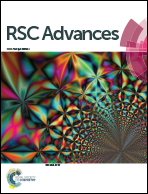Sensitive proteolysis assay based on the detection of a highly characteristic solid-state process
Abstract
This paper reported a sensitive proteolysis assay based on the detection of a highly characteristic solid-state process. In this study, acetylated peptides at the N-terminal were employed as the blockers of electrochemical signals. Silver nanoparticles (AgNPs) were used as electrochemical species which provided significant stripping current peaks. In the presence of proteases, the designed peptides could be cleaved and released amino groups which interacted with AgNPs and located the electrochemical species on the electrode. By detecting the linear sweep voltammetry, proteolysis processes could be sensitively monitored. We took trypsin and caspase-3 as two examples of proteases. This biosensing platform performed well towards the detection of both proteases. The detection limit for trypsin was 0.2 ng mL−1, and 0.1 pg mL−1 for caspase-3. Moreover, by changing the sequences of the substrate peptide, this method could be applied to detect different proteases. The utility in real samples was also checked with satisfactory results. Therefore, this method might have great potential use for the analysis of proteolysis and could be applied in clinical diagnostics.


 Please wait while we load your content...
Please wait while we load your content...